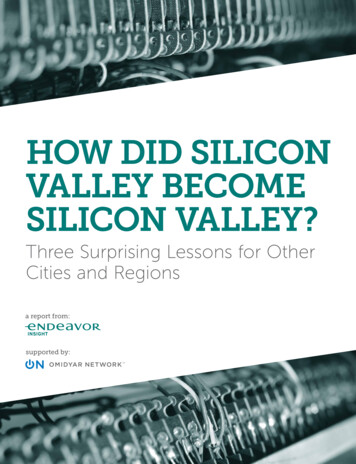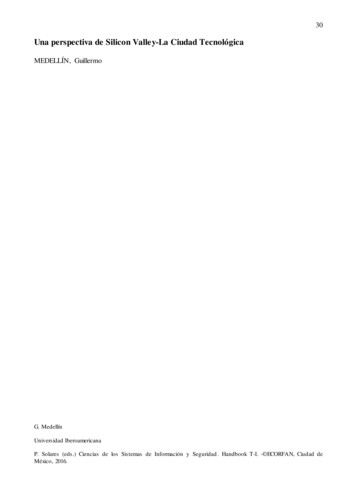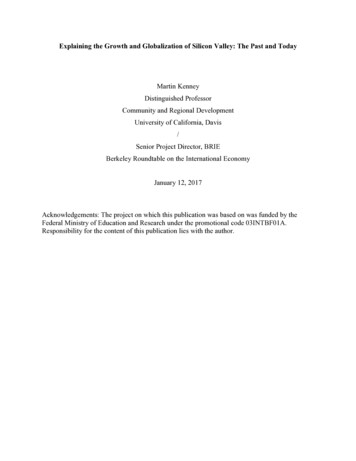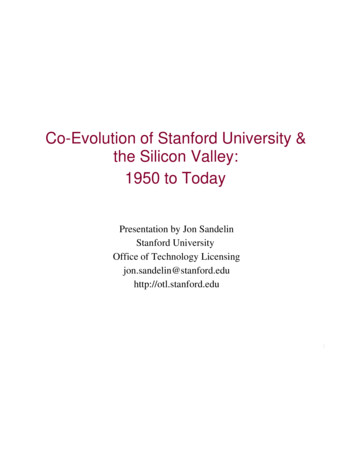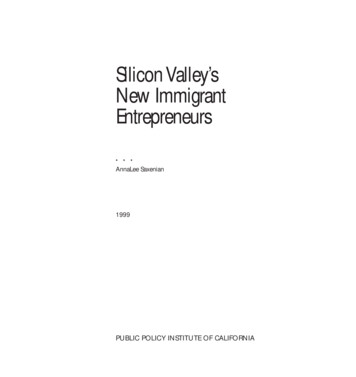
Transcription
Silicon Valley’sNew ImmigrantEntrepreneurs AnnaLee Saxenian1999PUBLIC POLICY INSTITUTE OF CALIFORNIA
Library of Congress Cataloging-in-Publication DataSaxenian, AnnaLee.Silicon Valley’s new immigrant entrepreneurs / AnnaLee Saxenian.p. cm.Includes bibliographical references.ISBN: 1-58213-009-41. Asian American businesspeople—California—Santa ClaraCounty. 2. Asian American scientists—California—Santa Clara.3. Immigrants—California—Santa Clara County.I. Title.HD2344.5.U62S367 1999331.6'235'079473—dc2199-28139CIPCopyright 1999 by Public Policy Institute of CaliforniaAll rights reservedSan Francisco, CAShort sections of text, not to exceed three paragraphs, may be quotedwithout written permission provided that full attribution is given tothe source and the above copyright notice is included.Research publications reflect the views of the authors and do notnecessarily reflect the views of the staff, officers, or Board ofDirectors of the Public Policy Institute of California.
ForewordIn the 1940s, the author Carey McWilliams coined a phrase tocharacterize California’s penchant for innovation and experimentation.He called it “the edge of novelty” and remarked that “Californians havebecome so used to the idea of experimentation—they have had toexperiment so often—that they are psychologically prepared to tryanything.” Waves of migrants and immigrants over the past 150 years ofCalifornia history have been attracted to our “edge of novelty,” and theyhave consistently found California a place that fosters creativity and theentrepreneurial spirit. In this report, AnnaLee Saxenian documents oneof the latest, and most dramatic, examples of California as a location thatattracts immigrant entrepreneurs.Building on her earlier research on Silicon Valley, Saxenian takes acareful look at the role of immigrant capital and labor in thedevelopment of this showcase regional economy. She finds thatimmigrants account for one-third of the scientific and engineeringworkforce in Silicon Valley and that Indian or Chinese Chief Executiveiii
Officers are running one-fourth of all of the high-technology firms in theregion. We have progressed from the last days of the 19th century, whenimpoverished Chinese workers were building the American system ofrailroads, to the end of the 20th century, when highly skilled Chineseentrepreneurs are playing a key role in the development and expansion ofthe Information Age.Rather than a “brain drain” from the sending countries, Saxeniansees the emergence of a “brain circulation” as immigrants return to theirhome countries to take advantage of promising opportunities or play akey role in building markets in their native countries from a Californiabase. Saxenian suggests that there is a healthy flow of financial andintellectual capital between Taiwan, India, and California and that thisflow has made a major contribution to technological innovation and tothe economic expansion of the state.Saxenian locates these findings at the center of the national debateover the role of highly skilled immigrant labor in the expansion of theU.S. economy and whether skilled immigrants are displacing nativeworkers. She concludes that immigrant entrepreneurs in Silicon Valleycreate both new jobs and important economic linkages that are central tothe continuing success of the California economy. The strength of theCalifornia economy has historically derived from its openness anddiversity—and that is why Carey McWilliams observed that the state andnation benefit from Californians living on “the edge of novelty.”David W. LyonPresident and CEOPublic Policy Institute of Californiaiv
SummaryScholars have devoted considerable attention to California’simmigrants but have focused their research almost exclusively on thelow-skilled population. We know very little about the economiccontributions of more highly skilled immigrants. The role of high-skilledimmigrants is of growing importance to policymakers in Californiabecause foreign-born scientists and engineers account for a significantand growing proportion of the state’s workforce. This study examinesthe economic contributions of skilled immigrants—both directly, asentrepreneurs, and indirectly, as facilitators of trade with and investmentin their countries of origin. This research explores the changingrelationships between immigration, trade, investment, and economicdevelopment in an increasingly global economy.The focus of the study is Asian immigrant engineers and scientists inSilicon Valley. When local technologists claim that “Silicon Valley isbuilt on ICs” they refer not to the integrated circuit but to Indian andChinese engineers. Skilled immigrants account for at least one-third ofv
the engineering workforce in many of the region’s technology firms andthey are increasingly visible as entrepreneurs and investors. This case hasrelevance beyond the region. As the center of technological innovationas well as the leading export region in California, Silicon Valley serves asa model and a bellwether for trends in the rest of the state.Debates over the immigration of scientists and engineers to theUnited States focus primarily on the extent to which foreign-bornprofessionals displace native workers, or on the existence of invisiblebarriers to mobility, or “glass ceilings,” experienced by non-nativeprofessionals. Both approaches assume that the primary economiccontribution of immigrants is as a source of relatively low-cost labor,even in the most technologically advanced sectors of the economy. Theview from sending countries, by contrast, is that the emigration of highlyskilled personnel to the United States represents a significant economicloss, or “brain drain,” which deprives their economies of their best andbrightest.Neither view is adequate. The argument that immigrants displacenative workers needs to be balanced by evidence that foreign-bornscientists and engineers are generating new jobs and wealth for the stateeconomy. Nor is it valid to assume that skilled immigrants will staypermanently in the United States as they frequently did in the past.Recent research suggests that the “brain drain” may be giving way to anaccelerating process of “brain circulation” as immigrants who havestudied and worked in the United States increasingly return to theirhome countries to take advantage of opportunities there. Even thoseimmigrants who choose to remain in the United States are playing agrowing role in linking domestic technology businesses to those in theircountries of origin.vi
This study has four goals. First, it seeks to quantify the immigrantengineers’ and entrepreneurs’ presence in and contribution to the SiliconValley economy. Second, the study examines the extent to which skilledChinese and Indian immigrants are organizing ethnic networks in theregion like those found in traditional immigrant enterprises to supportthe often risky process of starting new technology businesses. Third, itanalyzes how these engineers are simultaneously building social andeconomic networks back to their home countries that further enhanceentrepreneurial opportunities within Silicon Valley. Finally, it exploresthe implications of these findings for the Silicon Valley and Californiaeconomies and for public policy.There is widespread recognition of the significance of immigrantentrepreneurship in traditional industries ranging from small-scale retailto garment manufacturing. But we have only anecdotal evidence ofimmigrant entrepreneurship in the newer, knowledge-based sectors of theeconomy. Yet it is in these dynamic new industries that immigrants withtechnical skills and strong connections to fast-growing overseas marketshave the potential to make significant economic contributions. Not onlyare these highly skilled immigrants more mobile than their predecessors,but the technology industries where they are concentrated areCalifornia’s largest and fastest growing exporters and leading contributorsto the state’s economic growth.This study employs a mix of research methods and strategies toaddress the challenges of limited data availability. It relies on threeprimary sources: (1) Data on immigrants’ education, occupations, andearnings reported are drawn from the Public Use Microdata Sample(PUMS) of the 1990 census; (2) the analysis of immigrantentrepreneurship is based on a customized Dun & Bradstreet database ofvii
11,443 high-technology firms founded in Silicon Valley between 1980and 1998; and (3) the balance of the findings reported in the study arebased on more than 100 in-depth interviews with engineers,entrepreneurs, venture capitalists, and other key actors in the SiliconValley and San Francisco. In addition, 25 interviews were conducted inthe Taipei and Hsinchu regions of Taiwan and 42 in the Bangalore,Bombay, and Delhi regions of India.The study demonstrates that foreign-born engineers in SiliconValley’s technology industry make a substantial and growingcontribution to regional job and wealth creation. In 1990, immigrantsaccounted for 32 percent of the region’s total scientific and engineeringworkforce. Their numbers have most likely increased since then, butreliable data will not be available until the next decennial census (2000).The focus on Chinese and Indian immigrants in the balance of this studyis driven by the results of this analysis, which shows that in 1990, twothirds of the region’s foreign-born engineers were from Asia. Of these,Chinese and Indian immigrants accounted for 74 percent of the totalAsian-born engineering workforce.The entrepreneurial contributions of these skilled immigrants areimpressive. In 1998, Chinese and Indian engineers, most of whomarrived in the United States after 1970 to pursue graduate studies, weresenior executives at one-quarter of Silicon Valley’s new technologybusinesses. These immigrant-run companies collectively accounted formore than 16.8 billion in sales and 58,282 jobs in 1998. Moreover,Chinese and Indian immigrants started companies at an accelerating ratein the 1990s.The economic contributions of immigrants are not limited to theirdirect role as engineers and entrepreneurs. Although Silicon Valley’s newviii
immigrant entrepreneurs are more highly skilled than their counterpartsin traditional industries, like those counterparts they have created a richfabric of professional and associational activities that facilitate immigrantjob search, information exchange, access to capital and managerial knowhow, and the creation of shared ethnic identities. The region’s mostsuccessful Chinese and Indian entrepreneurs rely heavily on such ethnicresources while simultaneously integrating into the mainstreamtechnology economy.These networks are not simply local. Silicon Valley’s new immigrantentrepreneurs are building far-reaching professional and business ties toregions in Asia. They are uniquely positioned because their languageskills and technical and cultural know-how allow them to functioneffectively in the business culture of their home countries as well as inSilicon Valley. A transnational community of Chinese—primarilyTaiwanese—engineers has thus fostered two-way flows of capital, skill,and information between California and the Hsinchu-Taipei region ofTaiwan. In this process, Silicon Valley–based entrepreneurs benefit fromthe significant flows of capital that these immigrants coordinate, as wellas from the privileged access that they provide to Asian markets and toTaiwan’s flexible, state-of-the-art semiconductor and personal computermanufacturing capabilities. Silicon Valley’s Indian-born engineers haveplayed a similar, but more arm’s-length role, linking technologybusinesses in Silicon Valley with India’s highly skilled softwareprogramming and design talent. These long-distance social networksenhance economic opportunities for California and for emerging regionsin Asia.This research suggests that skilled immigrants contribute to thedynamism of the Silicon Valley economy, both directly, as engineers andix
entrepreneurs, and indirectly, as traders and middlemen linkingCalifornia to technologically advanced regions of Asia. The challenge forpolicymakers will be to recognize these mutually beneficial connectionsbetween immigration, investment, trade, and economic development.Restricting the immigration of skilled workers, for example, could havesubstantially more far-reaching consequences for economic developmentthan most policymakers recognize, affecting not only the supply ofskilled workers but also the rate of entrepreneurship, the level ofinternational investment and trade, and California’s economic growth.x
ContentsForeword.iiiSummary.vFigures . xiiiTables . xvAcknowledgments . xvii1. INTRODUCTION AND OVERVIEW OF THESTUDY .Purpose and Organization of the Study .Note on Data Sources and Methodology .1472. OVERVIEW OF IMMIGRATION ANDENTREPRENEURSHIP IN SILICON VALLEY .The New Asian Immigrants .The New Immigrant Entrepreneurs .99213. THE ORIGINS OF SILICON VALLEY’S ETHNICNETWORKS .The Chinese Institute of Engineers: The “Grandfather” ofthe Chinese Associations .Into the Mainstream: The Asian American ManufacturersAssociation .The Proliferation of Chinese Professional and TechnicalAssociations .xi27343740
Breaking the Glass Ceiling: The Silicon Valley IndianProfessionals Association .Cross-Generational Mentoring: The Indus Entrepreneur .The Benefits of Local Ethnic Networks .4244504. THE GLOBALIZATION OF SILICON VALLEY’SETHNIC NETWORKS .Reciprocal Regional Industrialization: The Silicon Valley–Hsinchu Connection .Beyond Body-Shopping? Bangalore’s Software Boom .The Two Worlds Meet in Silicon Valley .Conclusion.566268715. CONCLUSION .7353AppendixA. Industrial, Geographic, and Occupational Definitions .B. Interview List .C. Public Immigrant-Founded or -Managed TechnologyCompanies Based in Silicon Valley .89About the Author .93xii7781
Figures2.1. Foreign Doctoral Recipients in Science andEngineering .162.2. Standardized Annual Earnings by Race and Occupationin Silicon Valley High-Technology Industries, 1989 .19xiii
Tables2.1. Silicon Valley Workers, 1990 .122.2. Immigration of Indians, Chinese, and Whites intoSilicon Valley High-Technology Industries, by Year .132.3. Science and Engineering Degrees Granted by UCBerkeley to Chinese Immigrants, by Nation of Origin,1980–1997 .152.4. Education of Indians, Chinese, and Whites in SiliconValley High-Technology Industries, 1990 .172.5. Occupations of Indians, Chinese, and Whites in SiliconValley High-Technology Industries, 1990 .182.6. 1998 Sales and Employment of Silicon Valley HighTechnology Firms Led by a Chinese or Indian CEO .232.7. Chinese- and Indian-Run Companies as Share ofTotal Silicon Valley High-Technology Start-Ups, 1980–1998 .242.8. Sectoral Distribution of Indian and Chinese HighTechnology Firms Started in Silicon Valley, 1980–1998 .263.1. Indian and Chinese Professional Associations in SiliconValley .29xv
AcknowledgmentsI would like to extend special thanks to Jehanbux Edulbehram, PeterHall, Jinn-yuh Hsu, Michelle Liao, and Sherman Luk for their excellentresearch assistance. Thanks also go to Michael Dardia, Hans Johnson,and Michael Teitz for their thoughtful technical reviews. Any errors aremine alone.xvii
1. Introduction and Overviewof the StudyImmigrants have received extensive scholarly and policy attention.Researchers have documented the growth and changing composition ofthe immigrant population, and they have debated the effect ofimmigration on the economy and on the provision of education andwelfare at state and national levels. However, that work has focusedalmost exclusively on low-skilled immigrants. We know little about theeconomic contributions of highly skilled immigrants, particularly in anincreasingly global economy. This issue is of growing importance topolicymakers in California, where foreign-born scientists and engineersaccount for a significant and growing proportion of the state’s workforce.This study explores the extent to which highly skilled immigrants createjobs and wealth for the California economy—both directly, asentrepreneurs, and indirectly, as middlemen who facilitate trade andinvestment linkages to their countries of origin. The analysis suggeststhat policymakers need to recognize the changing relationships between1
immigration, trade, and economic development in an increasingly globaleconomy.Debates over the immigration of scientists and engineers to theUnited States focus primarily on the extent to which foreign-bornprofessionals displace native workers, or on the existence of invisiblebarriers to mobility, or “glass ceilings,” experienced by non-nativeprofessionals. Both approaches assume that the primary economiccontribution of immigrants is as a source of relatively low-cost labor,even in the most technologically advanced sectors of the economy.1 Theview from sending countries, by contrast, has historically been that theemigration of highly skilled personnel to the United States represents asignificant economic loss, or “brain drain,” which deprives theireconomies of their best and brightest.Neither of these views is adequate in today’s increasingly globaleconomy. Debates over the extent to which immigrants displace nativeworkers overlook evidence that foreign-born scientists and engineers arestarting new businesses and generating jobs and wealth for the stateeconomy at least as fast as their native counterparts.2 Similarly, thedynamism of emerging regions in Asia and elsewhere means that it is nolonger valid to assume that skilled immigrants will stay permanently in1See, for example, Kevin F. McCarthy and Georges Vernez, Immigration in aChanging Economy: California’s Experience, Santa Monica, CA: RAND, 1997.2This monograph documents the economic contribution of high-skilledimmigrants, but the broader debate concerning the overall costs and benefits ofimmigration are beyond its scope. For more background on this debate, see George J.Borjas, “The Economics of Immigration,” Journal of Economic Literature, Vol. 32, No. 4,December 1994, and “The Economic Benefits from Immigration,” Journal of EconomicPerspectives, Vol. 9, No. 2, Spring 1995; Rachel M. Friedberg and Jennifer Hunt, “TheImpact of Immigrants on Host Country Wages, Employment and Growth,” Journal ofEconomic Perspectives, Vol. 9, No. 2, Spring 1995; and James P. Smith and BarryEdmonston (eds.), The New Americans: Economic, Demographic, and Fiscal Effects ofImmigration, Washington, D.C.: National Academy Press, 1997.2
the United States. Recent research suggests that the “brain drain” maybe giving way to a process of “brain circulation,” as talented immigrantswho study and work in the United States return to their home countriesto take advantage of promising opportunities there.3 And advances intransportation and communications technologies mean that even whenthese skilled immigrants choose not to return home, they still play acritical role as middlemen linking businesses in the United States to thosein geographically distant regions.There is widespread recognition of the significance of immigrantentrepreneurship in traditional industries ranging from small-scale retailto garment manufacturing. Yet we have only anecdotal evidence of aparallel process in the newer, knowledge-based sectors of the economy. 4Yet it is in these dynamic new industries that immigrants with technicalskills and strong connections to fast-growing overseas markets have thepotential to make significant economic contributions. Not only areskilled immigrants highly mobile, but the technology industries in which3This varies significantly from country to country. An average of 47 percent of the1990–1991 foreign doctoral recipients in science and engineering from U.S. universitieswere still working in the United States in 1995. However, 88 percent and 79 percent ofthose from China and India, respectively, remained in the United States, compared toonly 13 percent, 11 percent, and 42 percent from Japan, South Korea, and Taiwan,respectively. See Jean M. Johnson and Mark C. Regets, “International Mobility ofScientists and Engineeers to the United States—Brain Drain or Brain Circulation?”National Science Foundation Issue Brief, NSF 98-316, June 22, 1998.4On traditional industries, see Roger Waldinger, Howard Aldrich, Robin Ward andAssociates, Ethnic Entrepreneurs: Immigrant Business in Industrial Societies, NewburyPark, CA: Sage, 1990. On technology industries, see Bill Ong Hing and Ronald Lee(eds.), The State of Asian Pacific America: Reframing the Immigration Debate, Los Angeles,CA: Leadership Education for Asian Pacifics and UCLA Asian American Studies Center,1996.3
they are concentrated are California’s largest and fastest-growingexporters and leading contributors to the state’s economic growth.5Purpose and Organization of the StudyThis study examines the entrepreneurial contribution of skilledimmigrants—in this case immigrant scientists and engineers—to theSilicon Valley economy. As the center of technological innovation aswell as the leading export region in California, Silicon Valley serves bothas a model and as a bellwether for trends in the rest of the state. Thereare, for example, large numbers of foreign-born engineers in Southern aswell as Northern California.6The aims of this study are fourfold. First, it quantifies immigrantengineers’ and entrepreneurs’ presence in and contribution to the SiliconValley economy. Second, the study examines the extent to which skilledChinese and Indian immigrants are organizing ethnic networks in theregion like those found in traditional immigrant enterprises to supportthe often risky process of starting new technology businesses. Third, itanalyzes how these engineers are building long-distance social andeconomic networks back to their home countries that further enhanceentrepreneurial opportunities within Silicon Valley. Finally, it exploresthe implications of these findings for the Silicon Valley and Californiaeconomies and for public policy.5Cynthia Kroll, Dwight M. Jaffee, Ashok Deo Bardhan, Josh Kirschenbaum, andDavid K. Howe, Foreign Trade and California’s Econmic Growth, California PolicySeminar Research Report, University of California, 1998.6Roger Waldinger and Mehdi Bozorgmehr (eds.), Ethnic Los Angeles, New York:Russell Sage Foundation, 1996; Paul Ong, Edna Bonacich, and Lucie Cheng (eds.), TheNew Asian Immigration in Los Angeles and Global Restructuring, Philadelphia: TempleUniversity Press, 1994.4
The next chapter documents the growing presence of foreign-bornengineers in Silicon Valley’s technology industries and assesses theireducational, occupational, and income status. The focus on Chinese andIndian engineers in the study is driven by the results of this analysis,which shows that these two groups, most of whom arrived in the UnitedStates after 1970, account for a majority of the region’s high-skilledimmigrants. Although these immigrants have achieved income andoccupational status comparable to their native counterparts inprofessional jobs, their opportunities for advancement to managementoccupations appear more limited, suggesting the possibility of a “glassceiling” or invisible barriers to career mobility.The region’s Chinese and Indian engineers have responded to thelimits on their professional advancement in two ways. Many individualsresponded in typical Silicon Valley fashion: They left establishedcompanies to start their own businesses. Chapter 2 shows that by 1998,Chinese and Indian engineers were running one-quarter of SiliconValley’s technology businesses. These companies collectively accountedfor more than 16.8 billion in sales and 58,282 jobs (and for 17 percentand 14 percent of the total sales and jobs, respectively). Moreover, thedata suggest that the pace of immigrant entrepreneurship has beenaccelerating.Silicon Valley’s skilled immigrants also responded collectively to asense of exclusion from established business and social structures.Chapter 3 describes how Chinese and Indian engineers have created awide range of professional and technical networks and institutions thatfacilitate professional advancement for recently arrived immigrants.Although these new immigrant entrepreneurs are more highly skilledthan their counterparts in traditional industries, they have created a rich5
fabric of associational activities that facilitate job search, informationexchange, and access to capital and managerial know-how as well as thesharing of ethnic identities. The region’s most successful Chinese andIndian entrepreneurs appear to rely on such ethnic resources whilesimultaneously integrating into the mainstream technology economy.These networks are not simply local. Chapter 4 demonstrates thatSilicon Valley’s Chinese and Indian immigrant engineers are buildingprofessional and economic ties back to their home countries. Theselong-distance networks are accelerating the globalization of labor marketsand enhancing opportunities for entrepreneurship, investment, and tradeboth in California and in newly emerging regions in Asia. Atransnational community of Taiwanese entrepreneurs, for example, hasfostered two-way flows of capital, skill, and information and a process ofreciprocal industrialization between Silicon Valley and the Hsinchuregion of Taiwan. Indian-born engineers are playing a similar, but morearm’s-length, middleman role linking producers in Silicon Valley withIndia’s booming software export industry. The growing presence ofMainland Chinese engineers in the Silicon Valley workforce suggests thepotential for comparable networks connecting California to the dynamiccoastal regions of China.Chapter 5 concludes that immigrant entrepreneurs contributesignificantly to the health and dynamism of the Silicon Valley economy.It urges policymakers to recognize the mutually beneficial connectionsbetween immigration, technology transfer, and trade—rather thanviewing them as zero-sum processes.6
Note on Data Sources and MethodologyThis study employs a mix of research methods and strategies toaddress the challenges of limited data availability. It relies on threeprimary sources. Data on immigrants’ education, occupations, andearnings are drawn from the Public Use Microdata Sample (PUMS) ofthe 1990 census. The decennial census provides the only comprehensivedata on immigrants by industry and occupation in the United States.Unfortunately, they are extremely dated. There is ample evidencesuggesting that the Asian presence in Silicon Valley increasedsignificantly during the 1990s, but industrial and occupational detail isnot available. As a result, the data on the quantitative significance ofimmigrant engineers presented here almost certainly represent asignificant undercount, but we will need to await the 2000 census todocument the scale of the increase.7 Appendix A provides detail on thedefinitions of industrial, geographic, and occupational categories used forthis analysis.The analysis of immigrant-run businesses in Chapter 2 is drawnfrom a customized Dun & Bradstreet database of 11,443 hightechnology firms founded in Silicon Valley between 1980 and 1998.Immigrant-run businesses were identified as all of the companies withchief executive officers (CEOs) with Chinese and Indian surnames.Although this group includes Chinese and Indians born in the UnitedStates, it appears unlikely that this is a large source of bias because the7Data on immigration from the Census Bureau’s March 1998 Current PopulationSurvey show that the foreign-born population of the United States grew by 6.5 millionbetween 1990 and 1998—far more than in any decade since 1900—and accounted for32 percent of the total U.S. population growth during the same period. California’simmigrant population alone increased by 2.2 million. Steven A. Camarota, Immigrantsin the United States—1998: A Snapshot of America’s Foreign-Born Population, Center forImmigration Studies (www.cisc.org), 1999.7
great majority of Asian engineers in the region are foreign-born. It isimportant to note, however, that we are using immigrant-run businessesas a proxy for immigrant-founded businesses in the absence of direct dataon firm founders. This likely understates the scale of immigrantentrepreneurship in the region because firms that were started by Chineseor Indians but have hired non-Asian outsiders as CEOs are not counted.Our interviews suggest that this has often been the case in Silicon Valley,and it is likely a more significant source of bias than the oppositescenario, i.e., firms started by someone other than a Chinese or Indianand having an Asian CEO. Appendix C provides a list of 59 publictechnology firms in Silicon Valley that were founded by or are currentlyrun by Chinese or Indians.The findings reported in the balance of this study are based on morethan 100 in-depth interviews with engineers, entrepreneurs, venturecapitalists, policymakers, and other key actors in Silicon Valley. Theseinterviews typically lasted at least one hour and were conducted betweenJanuary 1997 and January 1998. An additional 67 interviews wereconducted in the T
manufacturing capabilities. Silicon Valley's Indian-born engineers have played a similar, but more arm's-length role, linking technology businesses in Silicon Valley with India's highly skilled software programming and design talent. These long-distance social networks enhance economic opportunities for California and for emerging regions .
